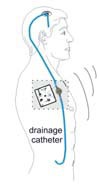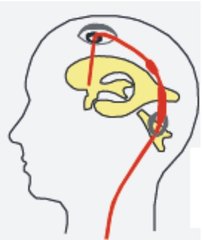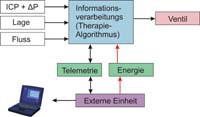iShunt
Contact person
Project description
The human brain is immersed in the so-called cerebrospinal fluid (CSF), which protects the brain from mechanical stress (e.g. concussion), helps support its weight through buoyancy and also serves for the nutrient supply of the brain. In normal situations, production and reabsorption of this fluid are balanced. However, disruption of this balance can lead to a build-up of fluid in the skull (Hydrocephalus). In this case, the most common solution today is the implantation of a passive pressure-control valve and catheter system (called “shunt”, see figure..) which drains excess fluid into another body compartment (usually the stomach cavity). Every year 18,000 Hydrocephalus patients are implanted with shunts. The existing shunts often show severe problems with the adaption of the CSF drainage to the physiological circumstances, leading to an unhealthy over- or underdrainage.
Project goals
Therefore the project “iShunt” (funded by the German federal government) aims at the development of new intelligent implants for an adaptive drainage of CSF. On the basis of physiological measurement data (like intracranial pressure, body position, flow of fluid, pulse amplitude, elasticity of the brain, amount of pathological intracranial pressure waves) and their interpretation, an adjusted drainage shall be realised. For the sake of patient monitoring the measuring data shall be transmitted via telemetry to the outside.
Subprojects
Development of an implant
- Requirements- and risk analysis
- Conception of new implant solutions with emphasis on a mechatronic design for the controlled CSF-drainage
- Construction and assembly of a prototype and a suitable test rig
Control engineering
- Investigation of relevant parameters for the control of CSF drainage
- Development of therapy algorithms for the purposeful CSF drainage
- Development of Matlab/Simulink models of the biological mechanisms for the analysis of new therapy algorithms with an electronically controlled valve
Signal processing
Intracranial pressure (ICP) serves as one helpful parameter for the diagnosis of Hydrocephalus. It correlates with breathing and pulse and changes with the body position and in situations like coughing, bleb filling and muscle tension. ICP is furthermore subject to so-called sinusoidal or ramp-formed B-waves, which accumulate in sick people. Particulary dangerous for Hydrocephalus-patients is the so-called A-wave, which causes a fast and steep rise in ICP. For the analysis of signals, different algorithms will be developed and tested in clinical context with an ICP-wave-monitor.
Hardware development and programming
- Development of a telemetry- and energy transmission-concept
- Integration of actuating elements and sensor systems
Measurement technique and test engineering
- Experimental tests of evaluation models in test plants in laboratory (valve- and pressure waves test plant)
- Extension of existing test plants
Medical evaluations after intensive laboratory examination
- Animal studies for the validation of intelligent implant solutions
- Evaluation of the control concepts at humans in form of an external drainage
Project partners
- University of Saarland, Neurological Clinic
- Raumedic AG
- Reco Medizintechnik e.K.
- Supported by the German Federal Ministry of Research (BMBF)
Veröffentlichungen
- M. Walter: Mechatronische Systeme für die Hydrozephalustherapie. Shaker Verlag, 2002
- S. Jetzki, S. Leonhardt. An electronic implant for Hydrocephalus therapy assistance. IEEE EMBS Conference, Vancouver, CA, August 20-24, 2008









